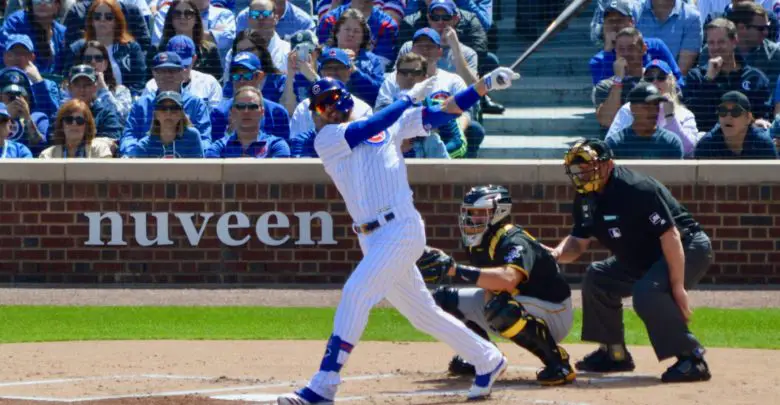
Kris Bryant Just Did Something We Haven’t Seen Since 2016
Ed note: If you’re here because you searched for news on Kris Bryant after seeing that he left Wednesday’s game early, fear not. He’d been DH’ing in Seattle due to a tight hamstring and there was no reason to keep him in there with a 9-0 lead. Now that you’ve satisfied your curiosity, please read on.
The tricky thing about batting average is that it doesn’t tell you how a player is doing right now, or even in the last couple weeks depending on how big a total sample you’re dealing with. In Kris Bryant’s case, people see a former MVP hitting .230 and wonder whether the shoulder is really healthy. However, too much focus on outcomes can obscure the process.
Yes, positive outcomes are required to a great degree, since no one wins games based on the aesthetics of their plate approach or having a really high exit velocity. But it’s an immutable fact that hitting the ball really hard is a good way to get hits, which is why Kris Bryant’s 1-for-4 performance in Tuesday’s win looks better when you look deeper.
Check out the exit velocities of the four balls he put in play, then check the launch angle. The 41 is an outlier and isn’t what you’d call ideal contact, but even that one had a .310 expected batting average (xBA, a measure of the likelihood that a batted ball will become a hit). For further context, his lineout to right had a .650 xBA; his lineout to left had a .700 xBA; the only hit he recorded, a double down the line in left, had a .730 xBA.
Kris Bryant tonight. Only one hit to show for it but he’s ripping the ball. pic.twitter.com/rdeYPzANTk
— Cubs Insider (@realcubsinsider) May 1, 2019
Now, we really need to look at what it means that Bryant hit four balls with an exit velocity of 105 mph or higher, since the Philistines among you either don’t understand or don’t care about the significance. And if you’re in the latter camp, what are you even doing still reading this? Anyway, the feat Bryant accomplished is a rare one.
In fact, he hasn’t generated that kind of repeated elite exit velo since his MVP season in 2016.
Kris Bryant's batted balls tonight in Seattle:
105.4 mph linneout in 1st
105.0 mph flyout in 3rd
110.6 mph double in 5th
108.3 mph flyout in 9th.KB ties a career-best for 4 batted balls 105+mph, done twice before — both in his NL MVP season in '16. #Cubs pic.twitter.com/QGvS7ogYes
— Daniel Kramer (@DKramer_) May 1, 2019
Once or twice might be considered luck, but a hitter with a bum wing and faulty mechanics doesn’t do that. And it’s not as though he was just putting a light swing on big fastballs and letting the pitcher do the work. Each of those batted balls was turned around anywhere from 14.9–31.3 mph harder than they were pitched.
That’s largely a result of the mechanical fix I’ve talked about here and on Inside Corner, just a simple correction in hand path. Bryant had been letting his top hand drop too low, which resulted the barrel of his bat falling below his hands as he came through the zone. Coupled with a bit of a lunge, Bryant was swinging harmlessly through pitches he should have killed.
There was a mental aspect to it as well, an adjustment that had to take place as Bryant got reacquainted with his old swing after last year’s shoulder injury forced him to take a different approach. He also had to get comfortable with opposing pitchers’ revamped strategy, which saw them going up and away early, but busting him in on the hands late.
Bryant has taken advantage of pitchers staying away by ordering up two oppo tacos, a rarity for him earlier in his career. That’s not some kind of new phenomenon, though, since many of his college homers and 27 of the 43 homers he hit in the minors went to the right of center. Dude has strength to burn and going opposite-field is something he’s worked on for years.
We can look at all sorts of numbers in a vacuum and paint the picture we want to see, but things become less subjective when viewed in concert. For instance, Bryant’s .263 BABIP (.300 is about league average and Bryant’s career average is .341) tells us that he’s been the victim of a little bad luck. And we know from the information above, not to mention some stellar defensive plays earlier in the season that he’s been robbed a few times.
Oh, and remember all that swinging through pitches business. Bryant’s 18.2% strikeout rate is currently lower than in any previous season, plus his 12.4% walk rate is above his career average. And he’s doing that despite not seeing many pitches to hit. In the 32 at-bats prior to the Dodgers series, Bryant saw 130 total pitches. Wanna guess how many weren’t on the fringes of the zone or out of it completely?
If you guessed 16, you earn a treat. Pitchers aren’t going to continue avoiding the dangerous part of the zone at that high a clip, nor is Bryant to let them get away with as many mistakes when they’re made. Even with a sluggish start, he’s at a .355 OBP with a 110 wRC+ that puts him at 10% better than league average run production.
Over the last 10 games, Bryant is slashing .250/.404/.556 with a 151 wRC+ despite a .226 BABIP that’s 37 points lower than his already anemic season average. When you put it all together, it screams that Bryant is really to bust out in a big way. And if you’re one who’s got to see it to believe it, make sure you keep your eyes open when No. 17 steps into the box.

